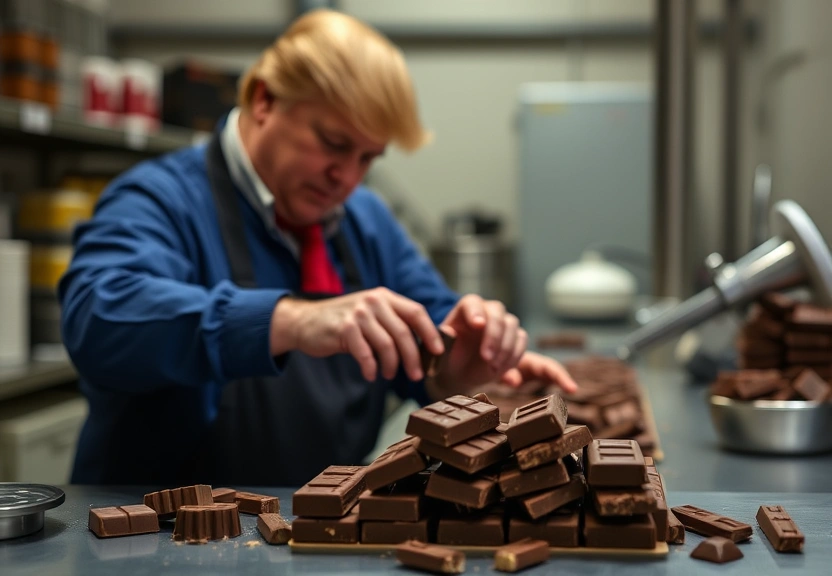How Trump’s Tariffs Boost Chocolate Makers in Canada and Mexico Over US Competitors
The introduction of tariffs on imported goods has been a hallmark of President Donald Trump’s economic policy. While these tariffs were primarily aimed at protecting American industries, they have inadvertently created a ripple effect that has benefited chocolate makers in neighboring Canada and Mexico. In this article, we will explore how Trump’s tariffs have shifted the competitive landscape in the chocolate industry, favoring Canadian and Mexican producers over their U.S. counterparts.

As the chocolate market continues to evolve, understanding the implications of these tariffs is crucial. With Canadian and Mexican chocolate makers capitalizing on the shift, U.S. companies are grappling with increased costs and reduced market share. This article will delve into the specifics of how tariffs have reshaped the chocolate industry, the competitive advantages gained by Canadian and Mexican producers, and what it means for U.S. chocolate manufacturers.
The Impact of Tariffs on the Chocolate Industry
Trump’s tariffs, particularly those on imported goods from countries like Mexico and Canada, were intended to encourage American manufacturing. However, the chocolate industry saw an unexpected twist in this narrative. The tariffs made imported chocolate ingredients, such as cocoa and sugar, more expensive for U.S. manufacturers. As a result, chocolate makers in Canada and Mexico found themselves in a more advantageous position, as they could source these ingredients at lower costs.
Understanding Tariffs and Their Purpose
Tariffs are taxes imposed on imported goods to protect domestic industries, reduce trade deficits, and encourage consumers to buy local products. While these tariffs may achieve their intended goals, they can also lead to unintended consequences. In the case of the chocolate industry, U.S. tariffs on imported cocoa products and sugar have hampered local producers’ ability to compete effectively.
Competitive Disadvantages for U.S. Chocolate Makers
With the imposition of tariffs, U.S. chocolate manufacturers are faced with several challenges:
- Increased Production Costs: Tariffs on imported raw materials have raised the cost of production for U.S. chocolate makers, forcing them to either absorb the costs or pass them onto consumers.
- Loss of Market Share: As Canadian and Mexican chocolate makers benefit from lower ingredient costs, they can offer more competitive pricing, leading to a loss of market share for U.S. companies.
- Reduced Profit Margins: Increased costs and decreasing sales have led to slimmer profit margins for U.S. chocolate manufacturers, impeding their ability to invest in innovation and marketing.
The Rise of Canadian and Mexican Chocolate Makers
As U.S. chocolate makers struggle with the implications of tariffs, Canadian and Mexican chocolate producers have been thriving. These manufacturers have strategically positioned themselves to capitalize on the shifting landscape.
Lower Production Costs
Chocolate makers in Canada and Mexico have access to more affordable cocoa and sugar, allowing them to produce chocolate at a lower cost. This competitive advantage has enabled them to price their products more attractively in both domestic and U.S. markets.
Quality and Innovation
In addition to cost advantages, Canadian and Mexican chocolate makers are increasingly focusing on quality and innovation. Many of these manufacturers are adopting sustainable practices and sourcing high-quality ingredients, which appeals to consumers who are willing to pay a premium for artisanal chocolates.
Market Response and Consumer Trends
Consumer preferences play a significant role in the chocolate market. As Canadian and Mexican chocolate makers gain traction, U.S. consumers are becoming more aware of the variety and quality of chocolates available from these countries.
Shifting Consumer Preferences
Many consumers are now seeking out unique flavors, artisanal products, and ethically sourced ingredients. This shift in consumer behavior presents an opportunity for Canadian and Mexican chocolate makers to carve out a niche in the U.S. market.
Marketing and Branding Strategies
Canadian and Mexican chocolate makers are employing savvy marketing strategies to promote their products. They emphasize their unique origins, sustainable sourcing, and artisanal craftsmanship, appealing to a growing segment of consumers interested in quality over quantity.
Future Outlook for U.S. Chocolate Makers
The future of U.S. chocolate makers remains uncertain as they navigate the challenges posed by tariffs and increased competition from Canada and Mexico. However, there are several strategies that U.S. companies can adopt to remain competitive in this evolving market.
Adapting to Market Conditions
U.S. chocolate makers must adapt to the changing market conditions by exploring new sourcing strategies, investing in product innovation, and enhancing their marketing efforts. By focusing on quality and establishing strong brand identities, they can differentiate themselves from their competitors.
Collaboration and Partnerships
Collaboration with local suppliers and producers may also prove beneficial for U.S. chocolate makers. By building strong partnerships within the supply chain, they can reduce costs and improve their overall product offerings.
Frequently Asked Questions (FAQs)
1. How have Trump’s tariffs specifically affected chocolate prices in the U.S.?
Trump’s tariffs have increased the cost of importing essential ingredients for chocolate production, leading to higher prices for consumers as manufacturers pass on these costs.
2. Why are Canadian and Mexican chocolate makers benefiting from U.S. tariffs?
Canadian and Mexican chocolate makers have lower production costs due to access to more affordable ingredients, allowing them to offer competitive pricing in the U.S. market.
3. What strategies can U.S. chocolate makers employ to compete with foreign producers?
U.S. chocolate makers can focus on quality improvement, innovative flavors, and effective branding to differentiate themselves and attract consumers.
4. Are U.S. chocolate manufacturers facing any other challenges besides tariffs?
Yes, they are also facing issues such as changing consumer preferences, the rise of e-commerce, and increased competition from artisanal chocolate brands.
5. What does the future hold for the chocolate industry in North America?
The chocolate industry in North America is likely to see continued competition between U.S., Canadian, and Mexican manufacturers, with a growing emphasis on quality and sustainability.
Conclusion
Trump’s tariffs have created a complex dynamic within the chocolate industry, benefiting Canadian and Mexican chocolate makers while presenting challenges for U.S. manufacturers. As the market continues to evolve, U.S. chocolate makers must adapt to these changes to remain competitive. By focusing on quality, innovation, and strategic partnerships, they can reclaim their position in the chocolate market and meet the demands of today’s consumers. The interplay between tariffs and consumer preferences will undoubtedly shape the future of chocolate production in North America.
📰 Original Source
Este artigo foi baseado em informações de: https://www.investing.com/news/stock-market-news/trumps-tariffs-give-chocolate-makers-in-canada-mexico-an-edge-over-us-firms-4158902


